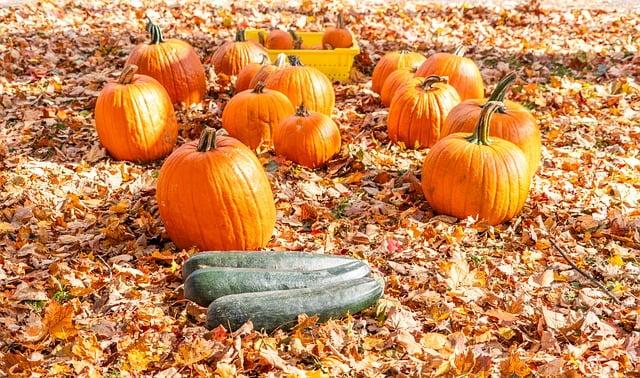Once upon a time, in a small village, the harvest was bountiful, but the winter loomed ahead. The villagers, grateful for their crops, decided to celebrate their good fortune. They gathered around a large table, sharing food and stories, giving thanks for the blessings of the year. As they feasted, they realized that gratitude brought them closer together. From that day on, they named this gathering “Thanksgiving,” a day to honor their harvest and the bonds of community. And so, the tradition spread, reminding all to cherish what they have.
Table of Contents
- The Historical Roots of Thanksgiving and Its Name
- Cultural Significance: How Thanksgiving Reflects Gratitude
- Modern Interpretations: Evolving Traditions and Their Meanings
- Celebrating Thanksgiving: Tips for Honoring the Spirit of the Day
- Q&A

The Historical Roots of Thanksgiving and Its Name
The origins of the holiday we now celebrate as Thanksgiving can be traced back to early 17th-century America, where the Pilgrims, a group of English settlers, sought refuge from religious persecution. In 1621, they held a harvest feast to give thanks for a bountiful crop, inviting the Wampanoag people to join in the celebration. This gathering is often regarded as one of the first Thanksgiving celebrations in the New World. The term “Thanksgiving” itself began to be used in the 1620s, reflecting the Pilgrims’ desire to express gratitude for their survival and the assistance they received from Native Americans during their first harsh winter.
Over the years, the meaning of Thanksgiving evolved, influenced by various cultural and religious practices. By the 19th century, the holiday had become a time for families to come together and reflect on their blessings. **Key elements that contributed to the establishment of Thanksgiving as a national holiday include:**
- The proclamation by President Abraham Lincoln in 1863, which called for a national day of “Thanksgiving and Praise to our beneficent Father who dwelleth in the Heavens.”
- The influence of Sarah Josepha Hale, a prominent writer who campaigned for the holiday to be recognized nationwide.
- The incorporation of traditional foods and customs that varied by region, further enriching the holiday’s significance.
The name “Thanksgiving” thus encapsulates a spirit of gratitude that has persisted through centuries, evolving into a cherished American tradition.

Cultural Significance: How Thanksgiving Reflects Gratitude
The essence of Thanksgiving lies in its deep-rooted tradition of expressing gratitude, a theme that resonates across various cultures and communities. This annual celebration serves as a reminder to pause and reflect on the abundance in our lives, fostering a sense of appreciation for both the tangible and intangible blessings we often take for granted. The act of gathering around a table filled with food not only nourishes the body but also strengthens the bonds of family and friendship, creating a space where stories are shared and memories are made. In this way, Thanksgiving transcends mere festivity; it becomes a ritual of connection and acknowledgment.
Throughout history, the holiday has evolved, yet its core message remains steadfast. The practice of giving thanks can be seen in various forms, from heartfelt prayers to communal feasts. This celebration encourages individuals to recognize and express gratitude for:
- Family and Friends: The support systems that enrich our lives.
- Health and Well-being: The physical and mental wellness that allows us to thrive.
- Opportunities: The chances we receive to grow and learn.
- Nature: The beauty and resources that sustain us.
By embracing these elements, Thanksgiving not only honors the past but also inspires a future rooted in appreciation and kindness, reminding us that gratitude is a powerful force that can transform our perspectives and relationships.

Modern Interpretations: Evolving Traditions and Their Meanings
The essence of Thanksgiving has transformed significantly over the years, reflecting the diverse cultural tapestry of modern society. Originally rooted in the early harvest celebrations of Native Americans and European settlers, the holiday has evolved into a multifaceted occasion that encompasses various traditions and meanings. Today, people celebrate Thanksgiving not only as a time to express gratitude for the harvest but also as an opportunity to acknowledge the interconnectedness of communities. This shift has led to a broader interpretation of the holiday, where the focus extends beyond familial gatherings to include themes of **unity**, **compassion**, and **social responsibility**.
As contemporary society grapples with issues of identity and belonging, Thanksgiving has become a platform for individuals to explore and redefine their own traditions. Many now incorporate elements that resonate with their personal or cultural backgrounds, leading to a rich mosaic of practices. Some common modern interpretations include:
- **Culinary Diversity**: Embracing a variety of dishes that reflect different heritages.
- **Community Service**: Engaging in acts of kindness, such as volunteering at shelters or organizing food drives.
- **Mindfulness and Reflection**: Taking time to contemplate personal growth and the importance of gratitude in everyday life.
This evolution highlights how Thanksgiving serves as a mirror to societal changes, allowing individuals to celebrate their unique narratives while fostering a sense of collective gratitude.

Celebrating Thanksgiving: Tips for Honoring the Spirit of the Day
Thanksgiving is a time to reflect on the blessings in our lives and to express gratitude for the people and experiences that enrich us. To truly honor the spirit of the day, consider incorporating meaningful traditions that foster connection and appreciation. **Gather your loved ones** around the table and encourage everyone to share what they are thankful for. This simple act can deepen relationships and create a warm atmosphere filled with love and gratitude. Additionally, **create a gratitude jar** where guests can write down their blessings throughout the day, adding a tangible element to the celebration that can be revisited in the future.
Another way to embrace the essence of Thanksgiving is by giving back to the community. **Volunteer at a local shelter** or organize a food drive to help those in need. This not only spreads joy but also reinforces the importance of compassion and generosity. Furthermore, consider **preparing a dish that honors your heritage** or a family recipe that has been passed down through generations. Sharing these culinary traditions can spark conversations and create a sense of belonging, reminding everyone of the rich tapestry of cultures that contribute to the holiday. By focusing on gratitude, connection, and service, we can celebrate Thanksgiving in a way that resonates deeply with its true meaning.
Q&A
-
What is the origin of the name “Thanksgiving”?
The term “Thanksgiving” originates from the English tradition of giving thanks for the harvest and blessings of the past year. It was first used in the early 17th century, particularly in relation to the harvest feast celebrated by the Pilgrims in 1621.
-
Why do we celebrate Thanksgiving?
Thanksgiving is celebrated to express gratitude for the harvest and the preceding year. It serves as a time for families and friends to come together, share a meal, and reflect on what they are thankful for.
-
How did Thanksgiving become a national holiday?
Thanksgiving was declared a national holiday by President Abraham Lincoln in 1863, during the Civil War, as a way to unify the nation and encourage gratitude amidst hardship. It was officially celebrated on the last Thursday of November.
-
What are common traditions associated with Thanksgiving?
Common traditions include:
- Sharing a meal, often featuring turkey, stuffing, and pumpkin pie.
- Participating in parades and football games.
- Volunteering to help those in need.
- Expressing gratitude through various means, such as sharing what one is thankful for.
As we gather around the table each year, let us remember the roots of Thanksgiving—a celebration of gratitude and togetherness. The name itself invites reflection on our blessings, reminding us to cherish the moments that unite us. Happy Thanksgiving!




